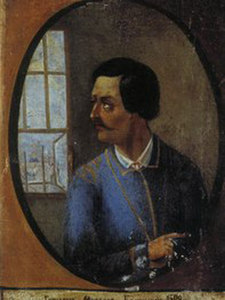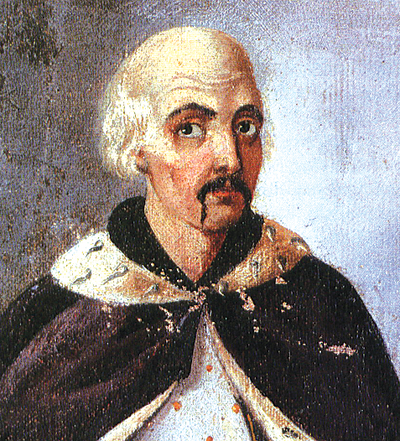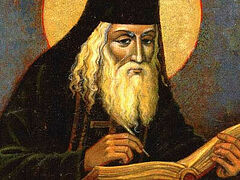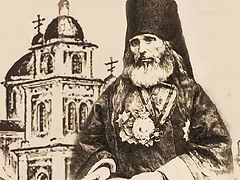We highly recommend that anyone wishing to understand what is now happening in the Ukrainian religious space to read this snippet of history of the state known as the Rzeczpospolita, or the Polish-Lithuanian Commonwealth. History has a way of repeating itself, and a pattern established in earlier times seems to be manifesting itself again on territory that was partially ruled by Polish kings four centuries ago.
 Krzysztof Kosiński Unlike the much-touted pogromists from Jesuits collegiums, the Lutherans and Calvinists had little more than personal rifles, pistols, and swords. Besides, they were simple merchants and craftsmen who were isolated and unorganized. The Ruthenians,1 as the forefathers of modern-day Ukrainians were formally called at the time, or Cossacks—“Cherkasy” as they were called based on the name of a military town on the bank of the Dnepr—were an entirely different matter. As they were living on the border of the Wild Field, the Cherkasy, also knows as Cossacks, had to carry out certain border defense duties to prevent annual invasions from the Crimean Khanate aimed at capturing slaves. The Cossacks also represented a considerable part of wojsko kwarciane, the regular army of Rzeczpospolita, and participated in numerous military conflicts and wars of that time. However, the authorities in Warsaw and Krakow made a different decision, considering the fairly low number of Cossacks officially registered for service and receiving service pay (at that time there were no more than five hundred of them). That was the authorities’ fatal mistake. Half a century after the first Cossack uprisings, practically all Orthodox Ruthenians who lived along the banks of the Dnepr registered for service. In other words, it included the entire right-bank Ukraine, all of southern Ruthenia. While the first Cossack uprising led by Krzysztof Kosiński was sporadic, and its goal was to loot the estate of the Orthodox magnates from the Ostrogsky line and avenge some minor offenses, the uprising led by Pavel—or Severyn—Nalyvaiko was religiously motivated. In the course of this uprising the Orthodox bishops Pociej and Terletsky started negotiating with Rome for the transfer of the southern Ruthenian lands to the patronage of the Roman Pontiff. In any case, the supporters of Nalyvaiko significantly damaged the estates of Kirill Terletsky, looted the bishop’s vestiary and found the bishop’s letters to the Roman Pontiff stating the willingness to submit the entire Russian Church to Rome’s management and guidance. Soviet historiographers, naturally, intentionally downplayed and practically ignored the religious component of Nalyvaiko’s uprising. They simply mentioned in passing a certain “national and religious oppression” that caused yet another liberating uprising of the working class. Nevertheless, the Orthodoxy of Ruthenians was aptly referred to as Nalyvaiko’s faith, which speaks volumes.
Krzysztof Kosiński Unlike the much-touted pogromists from Jesuits collegiums, the Lutherans and Calvinists had little more than personal rifles, pistols, and swords. Besides, they were simple merchants and craftsmen who were isolated and unorganized. The Ruthenians,1 as the forefathers of modern-day Ukrainians were formally called at the time, or Cossacks—“Cherkasy” as they were called based on the name of a military town on the bank of the Dnepr—were an entirely different matter. As they were living on the border of the Wild Field, the Cherkasy, also knows as Cossacks, had to carry out certain border defense duties to prevent annual invasions from the Crimean Khanate aimed at capturing slaves. The Cossacks also represented a considerable part of wojsko kwarciane, the regular army of Rzeczpospolita, and participated in numerous military conflicts and wars of that time. However, the authorities in Warsaw and Krakow made a different decision, considering the fairly low number of Cossacks officially registered for service and receiving service pay (at that time there were no more than five hundred of them). That was the authorities’ fatal mistake. Half a century after the first Cossack uprisings, practically all Orthodox Ruthenians who lived along the banks of the Dnepr registered for service. In other words, it included the entire right-bank Ukraine, all of southern Ruthenia. While the first Cossack uprising led by Krzysztof Kosiński was sporadic, and its goal was to loot the estate of the Orthodox magnates from the Ostrogsky line and avenge some minor offenses, the uprising led by Pavel—or Severyn—Nalyvaiko was religiously motivated. In the course of this uprising the Orthodox bishops Pociej and Terletsky started negotiating with Rome for the transfer of the southern Ruthenian lands to the patronage of the Roman Pontiff. In any case, the supporters of Nalyvaiko significantly damaged the estates of Kirill Terletsky, looted the bishop’s vestiary and found the bishop’s letters to the Roman Pontiff stating the willingness to submit the entire Russian Church to Rome’s management and guidance. Soviet historiographers, naturally, intentionally downplayed and practically ignored the religious component of Nalyvaiko’s uprising. They simply mentioned in passing a certain “national and religious oppression” that caused yet another liberating uprising of the working class. Nevertheless, the Orthodoxy of Ruthenians was aptly referred to as Nalyvaiko’s faith, which speaks volumes.
The Orthodoxy of Ruthenians was aptly referred to as Nalyvaiko’s faith, which speaks volumes
Nalyvaiko was captured near Lubny and executed in Warsaw immediately after Easter of 1597. It is not known whether he knew that almost all Orthodox hierarchs [in Ruthenia] had pledged allegiance to the Pope at the Council of Brest in the fall of 1596, while most of the people and clergy who had refused to follow them were declared apostates (to the church that was in essence already a Uniate church) and offenders against the laws of Rzeczpospolita. What lay in store for such offenders? Nothing but persecution, torture, death, violence and incessant pogroms.
However, we cannot say that all that was a coincidence and that the ill-fated bishops Terletsky and Pociej simply handed the Russian Church to the Pope on a silver platter in return for some short-term benefits. This process was fairly lengthy and complicated. It started even before the first Russian Councils of the early 1590s, at which Prince Konstanty Wasyl Ostrogski, the reigning ethnarch and the head of the Orthodox, discussed the possibility of uniting with Rome (his favorable views on these matters are also reflected in his correspondence with Hypatius Pociej). The process began much earlier, when the Moscow Church became autocephalous and the first Patriarch was appointed, and the Kiev Metropolia became subordinate to the Constantinople Patriarch, who, as ill fate would have it, was a subject of the Ottoman Empire. As such, his hands were tied with respect to the spiritual and administrative management of the newly acquired vast see in the southeastern parts of Rzeczpospolita. The situation was worsened by the fact that the Constantinople Patriarchs would visit the Polish Orthodox lands on their way from Moscow to which they travelled nearly every year with hat in hand to beg for donations from the Muscovy tsars. Besides, the local hierarchs felt that the Constantinople bishops were interfering with their affairs and their problematic relationship with the laity. For example, Patriarch Jeremiah had a good relationship with the Orthodox brotherhoods of the lay people, which was a snub to the Russian hierarchs who had complicated relationships with the brotherhoods. By the 1590s, the brotherhoods had become very rich and influential in Lvov, Vilna and Kiev. Being the donors to churches and monasteries and often having the decisive vote with regard to some routine issues, they were to a certain extent in opposition against the ruling bishops. However, I believe that these brotherhoods had some Protestant undertones—they demanded the right to elect clergy, to limit the bishops’ powers; they demanded that the bishop firmly hold to Orthodox beliefs, and that the brotherhoods have control over church income and expenses. In other words, they were interfering with the most sacred foundations of the Western Russian episcopacy. Naturally, the bishops were concerned by such demands and actions of the brotherhoods, because frankly speaking, cushy and lucrative jobs at the Russian bishoprics were simply bought by secular landowners for the purposes of personal enrichment.
 Nalyvaiko, Portrait, 17th Century
Nalyvaiko, Portrait, 17th Century
Lucrative jobs at the Russian bishoprics were simply bought by secular landowners
There are numerous examples confirming this. Sometimes, as a result of a snag in the government system, two candidates would be appointed to a vacant position, and they would then launch a real war, involving large armed troops, shelling of the cathedrals, assaults and sieges, numerous victims, pillaging and all conceivable excesses... Could such bishops and priests consistently and responsibly protect the interests of the Orthodox Church and laity oppressed by the tyranny of Societas Jesu, King Sigismund, and magnates of Rzeczpospolita? It is quite possible that the Polish kings deliberately appointed such ruffians and bandits to the positions in the South Russian churches to worsen the crisis and the dismal state of the Church at that time—the Church that had been founded by the Great Kievan princes and supported by thousands of saints of pre-Mongolian epoch. Unfortunately, all this had been forgotten by the end of the sixteenth century…
This is the reason why I provide this information about the Council of Brest of 1596, trying to avoid the details that are not relevant to the main story, even if they are important. I think that it was the Council that brought about the geopolitical and spiritual decline of Rzeczpospolita, the country without the inquisition fires, the country that once was the most powerful state in Europe.
And we should say this directly and unequivocally.
King Sigismund III, incited by the Jesuits and tempted by the turpitude and moral decay of the Russian episcopacy made a fatal mistake for which the Poles would have to pay over the course of 400 years.
Meanwhile, after the Council of Brest of 1596, Sigismund “legally” prescribed the local authorities to put down the opponents of the Unia. Speaking at the Warsaw Sejm on behalf of the Orthodox nobles from several voivodes of Rzeczpospolita, Prince Konstanty Ostrogsky, the Russian ethnarch, demanded that the powers of the bishops who had renounced Orthodoxy be taken away and transferred to the Orthodox bishops, as dictated by the traditional laws. When the king refused to do that, the Orthodox nobles who were against the Unia declared that they did not recognize the architects of the Unia as their bishops and wouldn’t allow them to exercise their powers in their lands. Although the brotherhoods and many representatives of the clergy continued to oppose the Unia, the freedoms of social self-determination and religion were coming to an end, and the decrees of the previous kings on religious liberty, while still intact on paper in the archives of Warsaw and Krakow, had been practically rescinded. In a way, the Unia had become a government program—so any opposition to it was considered a political rebellion.
The Unia had become a government program, so any opposition to it was considered a political rebellion.
The Vilna Brotherhood was the first to be punished. The universal royal decree dated May 22, 1596 ordered Metropolitan Mikhail Ragoza to try the members of the Vilna brotherhood as rebels and expel them from the Holhy Trinity Monastery, which the brotherhood owned. Many historians note that the government authorities consistently based their actions on the premise that the Uniate Church was the only lawful Church for the Orthodox people of Rzeczpospolita and stopped at nothing to achieve this goal, including intimidation and coercion. The churches run by the priests who didn’t accept the Unia were being shut down, the priests themselves were taken away from their parishes, and only the Uniate priests were allowed to perform the worship services. The Orthodox commoners were not allowed to become members of the local administrations, and the Orthodox tradesmen were kicked out of the trade guilds. The Uniate clergy actively encouraged the government bodies to carry out this policy, while the Catholic Church supported the policy with its spiritual authority.
Only twenty-five years later, on the night of August 15, 1620 the Jerusalem Patriarch Theophanes, guarded by the increased security in the Kiev Caves Lavra, reinstated the Kievan Orthodox Metropolia and later the Orthodox hierarchy as well. On October 6, 1620 the Patriarch ordained eight Russian bishops in the Brotherhood’s Church of the Theophany. These bishops later became well-known champions of Orthodoxy, enlightenment, and Russian culture. Influenced by hetman Sahaidachny, Job (Boretsky), the newly appointed Kievan Metropolitan, wrote the treatise entitled “Protest and Pious Justification”, while Zacharias Kopystensky wrote his polemic work Palinode, the Book of Faith, and others. Unlike the first polemic works of the late sixteenth century, these innovative works promoted the idea of a single ancestral homeland of the three Eastern Slavic nations, the inseparability of their historical destinies, the closeness of their languages, the unity of the Church Slavonic liturgical language and faith. Job (Boretsky) wrote in his Protest and Pious Justification:
“We have the same faith and worship service with Moscow, the same origin, language and customs”.
Naturally, all these events, negotiations and matters made the government of Rzeczpospolita very concerned. Yet no one saw them as the harbingers of the future to come soon. Violence, force and coercion were the only solutions, and the only objectives were to increase the pressure on the Orthodox, increase the persecution, and push them underground again…
In February and March 1621, Sigismund III issued decrees that proclaimed that the appointment of the Metropolitan and bishops by Patriarch Theophanes was unlawful because the Jerusalem Patriarchs have nothing to do with the Russian Church and that such hierarchal activities require the king’s approval. In these decrees, Theophanes was called an imposter and a Turkish spy. The persecution by the government authorities grew more severe. In this atmosphere of hopelessness, Metropolitan Job sent a proposal to Moscow in 1625 suggesting the merger of southern Ruthenia and right-bank Ukraine with Muscovy. However, the government of Tsar Mikhail Fedorovich Romanov, weakened by the Times of Troubles, didn’t dare to take that step, which would have obviously led to a new war with Poland.
The Orthodox hierarchy was recognized and legalized only after the death of king Sigismund, who till his last days remained a stalwart and implacable supporter of the inculcation of the Church Unia.
Surprisingly, the long reign of Sigismund in Rzeczpospolita is considered to be “the golden age” by Polish historians. It is true that in his time the Poles were part of the governing elite in Moscow’s Kremlin, and in the Times of Trouble the king’s son Vladislav was declared by the corrupt boyars to be the Ruler of Muscovy and received the honors of supreme power. Vladislav relinquished the title of The Great Duke of Muscovy only in 1634 and, for a price of 20,000 rubles, returned the tsar’s crown and regalia that he received from the boyars in 1610… In other words, he had been “the proclaimed Tsar of Muscovy” for twenty-four years, yet he never actually took possession of the tsardom—allegedly because of a regrettable misunderstanding.
Vladislav IV’s reign turned out to be the last relatively stable period in the history of Poland, even though it was during his time that the Zaparozhia Cossacks led by Bogdan Khmelnitsky began their uprising. Even earlier, in 1637–1638, Vladislav put down two other uprisings by Pavlyuk and Ostryanitsa. However, Polish scholars and historians still consider this to be “a relatively stable era”… What about the period after Vladislav’s death? It is simply referred to as the “Flood”, because Rzeczpospolita, weakened by the unending Khmelnitsky uprising and Sweden’s invasion, sunk into chaos and anarchy. Such were the real fruits of “peace and safety” proclaimed by Sigismund III at the Council of Brest.
It should be noted that the rebels’ banners bore the words, “destruction of the Unia, this bone of contention”. This demand for “acceptance of the Greek religion” had been repeated in one way or another since 1600, when the Orthodox finally realized that the Council of Brest was a sham that verbally proclaimed peace and love, while in reality separated the people who had hitherto fore been united.
The attempt to “unite” the two branches of Christianity was simply pernicious as this supposed victory had a flaw that caused the disintegration of the entire government structure and negated both the personal accomplishments of the two kings of the Vasa dynasty and the feats of the previous generations of Poles, Lithuanians and Russians who, based on the Union of Lublin, helped form a united state that included Poland, the Great Duchy of Lithuania, and some adjacent lands.
The entire government structure fell like a tree and turned to dust. That was the end, that was what it all had come down to. In the late eighteenth century, the once great and powerful Rzeczpospolita disappeared from the political map of Europe. Only the roots of the tree survived. They could only grow weak shoots of doomed Polish uprisings and riots that were cut off by the sharp sickle of the Russian empire.
That was the end of the forced and misguided “union” of things that should really be governed by another Power—a Power of which king Sigismund had no concept.



